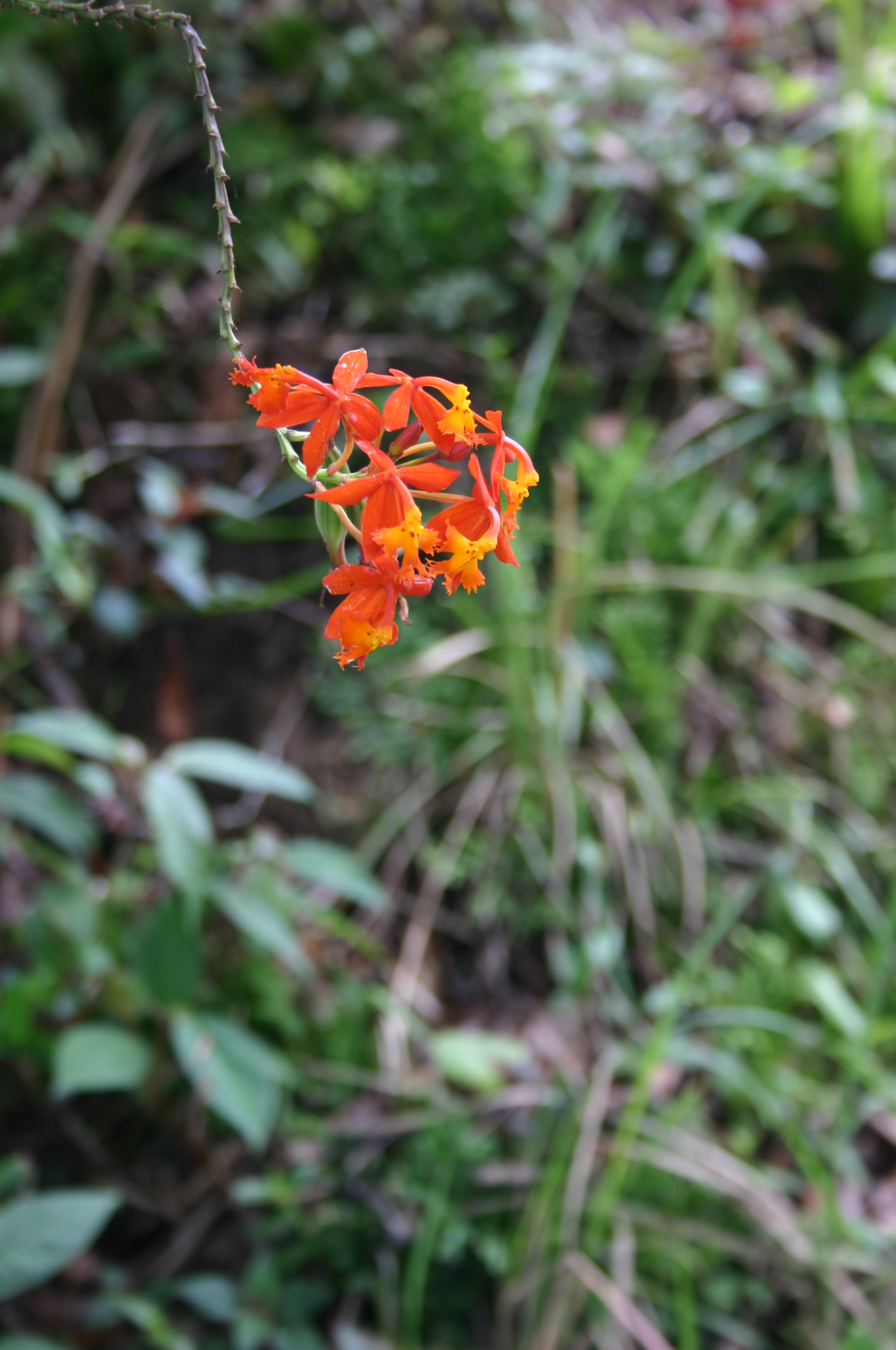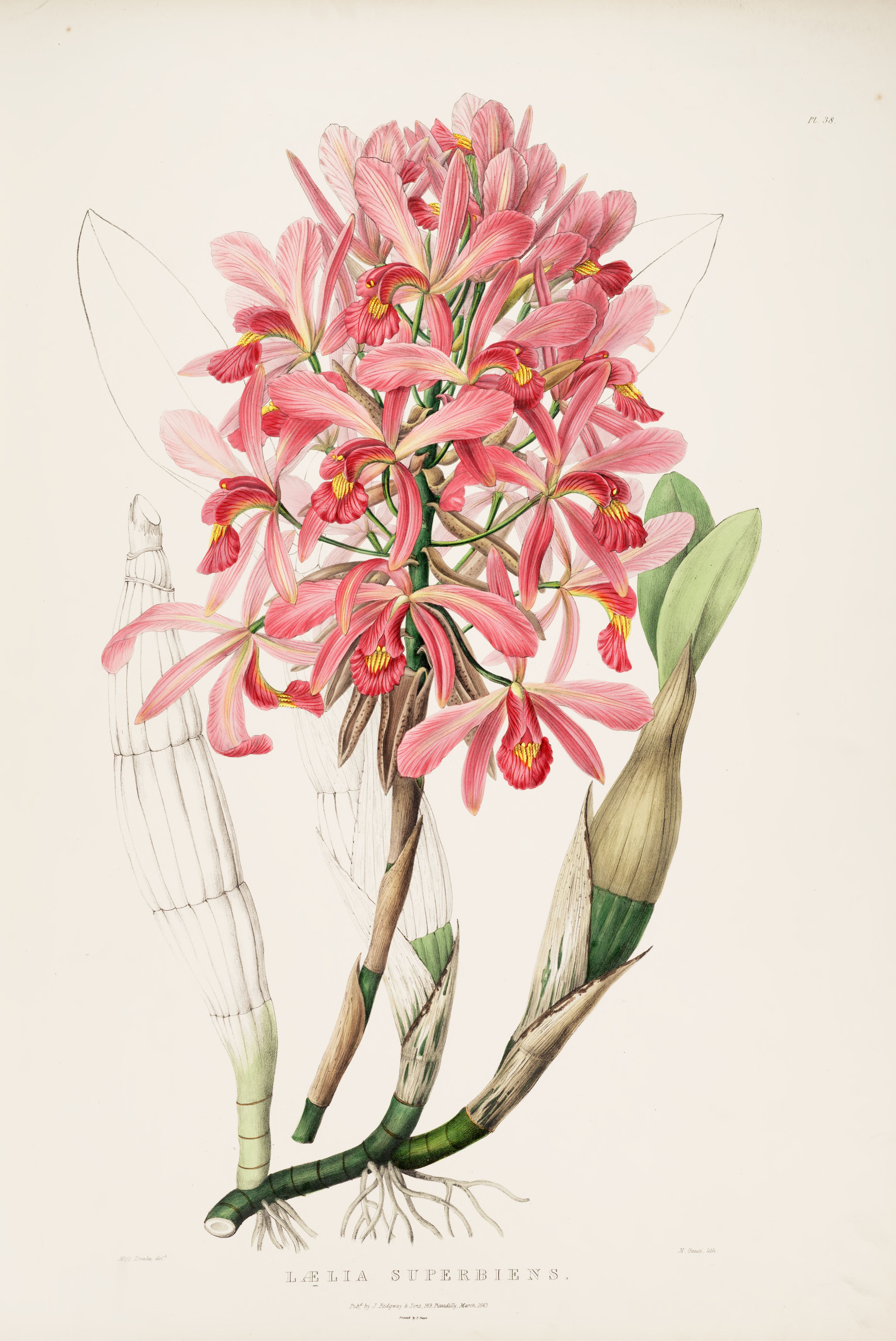|
Epidendrum Frutex
''Epidendrum frutex'' is a high-altitude species of reed-stemmed ''Epidendrum'' orchid native to Colombia, Ecuador, Peru, and Venezuela. Description ''E. frutex'' Rchb.f. (1855) is closely related to Epidendrum frigidum, E. frigidum Jean Jules Linden, Lind. (1855), growing terrestrially in "open sphagnum uplands". The tall sympodial plants grow from 3/4 to 5 m tall. As is typical of the subgenus Epidendrum subg. Epidendrum, ''E.'' subg. ''Epidendrum'', the stems are covered from the base with distichous, tubular, leaf-bearing sheaths. The narrow leathery leaves of ''E. frutex'' can grow more than 2 dm long. The terminal inflorescence is a distichous (not secund) compound panicle bearing numerous small, fleshy yellow to green to brown flowers. The triangular sepals are no longer than 6 mm. The linear petals are slightly shorter than the sepals. The Labellum (botany), lip is adnation, adnate to the column (botany), column to its apex, hear ... [...More Info...] [...Related Items...] OR: [Wikipedia] [Google] [Baidu] |
Heinrich Gustav Reichenbach
Heinrich Gustav Reichenbach (Dresden, 3 January 1823 – Hamburg, 6 May 1889) was a botanist and the foremost German orchidologist of the 19th century. His father Heinrich Gottlieb Ludwig Reichenbach (author of ''Icones Florae Germanicae et Helveticae'') was also a well-known botanist. Biography He started his study of orchids at the age of 18 and assisted his father in the writing of ''Icones''. He became a Doctor in Botany with his work on the pollen of orchids (see ‘Selected Works’). Soon after his graduation, Reichenbach was appointed to the post of extraordinary professor of botany at the Leipzig in 1855. He then became director of the botanical gardens at the Hamburg University (1863-1889). At that time, thousands of newly discovered orchids were being sent back to Europe. He was responsible for identifying, describing, classifying. Reichenbach named and recorded many of these new discoveries. He probably was not the easiest of personalities, and used to boast about ... [...More Info...] [...Related Items...] OR: [Wikipedia] [Google] [Baidu] |
Epidendrum Subg
''Epidendrum'' , abbreviated Epi in the horticultural trade, is a large neotropical genus of the orchid family. With more than 1,500 species, some authors describe it as a mega-genus. The genus name (from Greek ''επί, epi'' and ''δένδρον, dendron'', "upon trees") refers to its epiphytic growth habit. When Carl Linnaeus named this genus in 1763, he included in this genus all the epiphytic orchids known to him. Although few of these orchids are still included in the genus ''Epidendrum'', some species of ''Epidendrum'' are nevertheless not epiphytic. Distribution and ecology They are native to the tropics and subtropical regions of the American continents, from North Carolina to Argentina. Their habitat can be epiphytic, terrestrial (such as '' E. fulgens''), or even lithophytic (growing on bare rock, such as '' E. calanthum'' and '' E. saxatile''). Many are grown in the Andes, at altitudes between 1,000 and 3,000 m. Their habitats include humid jungles, ... [...More Info...] [...Related Items...] OR: [Wikipedia] [Google] [Baidu] |
Orchids Of Ecuador
Orchids are plants that belong to the family Orchidaceae (), a diverse and widespread group of flowering plants with blooms that are often colourful and fragrant. Along with the Asteraceae, they are one of the two largest families of flowering plants. The Orchidaceae have about 28,000 currently accepted species, distributed in about 763 genera. (See ''External links'' below). The determination of which family is larger is still under debate, because verified data on the members of such enormous families are continually in flux. Regardless, the number of orchid species is nearly equal to the number of bony fishes, more than twice the number of bird species, and about four times the number of mammal species. The family encompasses about 6–11% of all species of seed plants. The largest genera are '' Bulbophyllum'' (2,000 species), '' Epidendrum'' (1,500 species), '' Dendrobium'' (1,400 species) and '' Pleurothallis'' (1,000 species). It also includes '' Vanilla'' (the genu ... [...More Info...] [...Related Items...] OR: [Wikipedia] [Google] [Baidu] |
Epidendrum Subsect
''Epidendrum'' , abbreviated Epi in the horticultural trade, is a large neotropical genus of the orchid family. With more than 1,500 species, some authors describe it as a mega-genus. The genus name (from Greek language, Greek ''επί, epi'' and ''δένδρον, dendron'', "upon trees") refers to its epiphyte, epiphytic growth habit. When Carl Linnaeus named this genus in 1763, he included in this genus all the epiphytic orchids known to him. Although few of these orchids are still included in the genus ''Epidendrum'', some species of ''Epidendrum'' are nevertheless not epiphytic. Distribution and ecology They are native to the tropics and subtropics, subtropical regions of the Americas, American continents, from North Carolina to Argentina. Their habitat can be epiphyte, epiphytic, terrestrial (such as ''Epidendrum fulgens, E. fulgens''), or even lithophytic (growing on bare rock, such as ''Epidendrum calanthum, E. calanthum'' and ''Epidendrum saxatile, E. saxa ... [...More Info...] [...Related Items...] OR: [Wikipedia] [Google] [Baidu] |
Column (botany)
The column, or technically the gynostemium, is a reproductive structure that can be found in several plant families: Aristolochiaceae, Orchidaceae, and Stylidiaceae. It is derived from the fusion of both male and female parts (stamens and pistil) into a single organ. The top part of the column is formed by the anther, which is covered by an anther cap. This means that the ''style'' and ''stigma'' of the pistil, with the filaments and one or more anthers, are all united. Orchidaceae The stigma sits at the apex of the column in the front but is pointing downwards after resupination (the rotation by 180 degrees before unfolding of the flower). This stigma has the form of a small bowl, the clinandrium, a viscous surface embedding the (generally) single anther. On top of it all is the anther cap. Sometimes there is a small extension or little beak to the median stigma lobe, called rostellum. Column wings may project laterally from the stigma. The column foot is formed by the a ... [...More Info...] [...Related Items...] OR: [Wikipedia] [Google] [Baidu] |
Adnation
Adnation in Angiosperms is the fusion of two or more whorls of a flower, e.g. stamens to petals". This is in contrast to connation, the fusion among a single whorl A whorl ( or ) is an individual circle, oval, volution or equivalent in a whorled pattern, which consists of a spiral or multiple concentric objects (including circles, ovals and arcs). Whorls in nature File:Photograph and axial plane flo .... References Plant anatomy {{botany-stub ... [...More Info...] [...Related Items...] OR: [Wikipedia] [Google] [Baidu] |
Labellum (botany)
In botany, the labellum (or lip) is the part of the flower of an orchid or ''Canna'', or other less-known genera, that serves to attract insects, which pollinate the flower, and acts as a landing platform for them. ''Labellum'' (plural: ''labella'') is the Latin diminutive of ''labrum'', meaning lip. The labellum is a modified petal and can be distinguished from the other petals and from the sepal A sepal () is a part of the flower of angiosperms (flowering plants). Usually green, sepals typically function as protection for the flower in bud, and often as support for the petals when in bloom., p. 106 The term ''sepalum'' was coined ...s by its large size and its often irregular shape. It is not unusual for the other two petals of an orchid flower to look like the sepals, so that the labellum stands out as distinct. Bailey, L. H. ''Gentes Herbarum: Canna x orchiodes''. (Ithaca), 1 (3): 120 (1923); Khoshoo, T. N. & Guha, I. ''Origin and Evolution of Cultivated Cannas ... [...More Info...] [...Related Items...] OR: [Wikipedia] [Google] [Baidu] |
Panicle
A panicle is a much-branched inflorescence. (softcover ). Some authors distinguish it from a compound spike inflorescence, by requiring that the flowers (and fruit In botany, a fruit is the seed-bearing structure in flowering plants that is formed from the ovary after flowering. Fruits are the means by which flowering plants (also known as angiosperms) disseminate their seeds. Edible fruits in partic ...) be pedicellate (having a single stem per flower). The branches of a panicle are often racemes. A panicle may have determinate or indeterminate growth. This type of inflorescence is largely characteristic of grasses such as oat and crabgrass, as well as other plants such as pistachio and mamoncillo. Botanists use the term paniculate in two ways: "having a true panicle inflorescence" as well as "having an inflorescence with the form but not necessarily the structure of a panicle". Corymb A corymb may have a paniculate branching structure, with the lower flowers ha ... [...More Info...] [...Related Items...] OR: [Wikipedia] [Google] [Baidu] |
Sympodial
Sympodial growth is a bifurcating branching pattern where one branch develops more strongly than the other, resulting in the stronger branches forming the primary shoot and the weaker branches appearing laterally. A sympodium, also referred to as a sympode or pseudaxis, is the primary shoot, comprising the stronger branches, formed during sympodial growth. The pattern is similar to dichotomous branching; it is characterized by branching along stems or hyphae. In botany, sympodial growth occurs when the apical meristem is terminated and growth is continued by one or more lateral meristems, which repeat the process. The apical meristem may be consumed to make an inflorescence or other determinate structure, or it may be aborted. Types If the sympodium is always formed on the same side of the branch bifurcation, e.g. always on the right side, the branching structure is called a helicoid cyme or bostryx. If the sympodium occurs alternately, e.g. on the right and then the left ... [...More Info...] [...Related Items...] OR: [Wikipedia] [Google] [Baidu] |
Epidendrum
''Epidendrum'' , abbreviated Epi in the horticultural trade, is a large neotropical genus of the orchid family. With more than 1,500 species, some authors describe it as a mega-genus. The genus name (from Greek ''επί, epi'' and ''δένδρον, dendron'', "upon trees") refers to its epiphytic growth habit. When Carl Linnaeus named this genus in 1763, he included in this genus all the epiphytic orchids known to him. Although few of these orchids are still included in the genus ''Epidendrum'', some species of ''Epidendrum'' are nevertheless not epiphytic. Distribution and ecology They are native to the tropics and subtropical regions of the American continents, from North Carolina to Argentina. Their habitat can be epiphytic, terrestrial (such as '' E. fulgens''), or even lithophytic (growing on bare rock, such as '' E. calanthum'' and '' E. saxatile''). Many are grown in the Andes, at altitudes between 1,000 and 3,000 m. Their habitats include humid jungles, ... [...More Info...] [...Related Items...] OR: [Wikipedia] [Google] [Baidu] |
Jean Jules Linden
Jean Jules Linden (12 February 1817,Jean Linden, explorer and horticulturist in – 12 January 1898, in ) was a botanist, explorer, horticulturist and businessman. He specialised in s, which he wrote a number of books about. Jean Linden studied at the [...More Info...] [...Related Items...] OR: [Wikipedia] [Google] [Baidu] |




